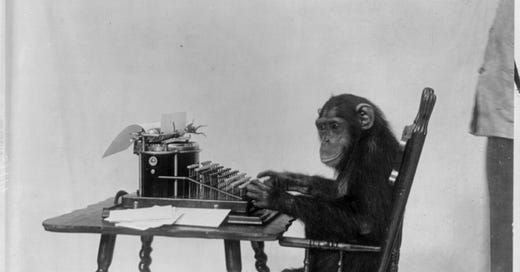Saturday Links
Disproving the infinite monkey theorem, the birth of Renaissance painting, why publishers have abandoned boys, the end of the in-flight magazine, and more.

Good morning! In the latest issue of The Lamp, Eduard Habsburg-Lothringen writes about reading Bram Stoker’s Dracula, young and old: “My first encounter with Dracula when I was a teenager was—as I was only to discover later—with an abridged version, which people with not much faith in kids’ abilities had ‘rendered more interesting.’ I think it is unfortunate that I read the novel when I was about twelve years old. I enjoyed the first third of it: the travels of Jonathan Harker in Transylvania and the beginning of the adventures in England. But all those scenes involving poor Lucy Westenra and her fate—involving a gruesome cemetery scene—absolutely terrified me as a child. Once the light in my bedroom was shut off I was terrified by thoughts of the ‘bloofer lady’ and the children she stalked. The words alone still give me goosebumps . . . To return to Dracula in the age of Internet is surprising and once again proves that good books should be read over and over again because they are completely different each time you open them.”
The birth of Renaissance painting: “A tremendous poster greets visitors to the Metropolitan Museum of Art in New York. Advertising the show of the season, Siena: The Rise of Painting, 1300-1350, the poster features a detail from the Raising of Lazarus (1310–11) by Duccio di Buoninsegna, founder of the Sienese school. It shows Christ, surrounded by a crowd, raising his extended arm. If you are familiar with the uncropped painting, you realize that on the right should appear Lazarus in his tomb, eyes now open, come to life at Christ’s command. The museum knows what it is doing: Christ’s dramatic gesture here encapsulates the show’s theme, namely how late medieval Sienese artists revitalized painting, remaking it into a more expressive, naturalistic medium.”
The end of the in-flight magazine: “There were, of course, other ways to feel connected with humanity on a plane. You could notice a slight indentation left in the seat from the person before you, or the length to which they had extended (or shortened) their seatbelt, which would now become yours. You didn’t have to turn to the back of the in-flight magazine to see some stranger’s—or, more likely, strangers’—handiwork on the crossword, or wonder what flavor of sticky substance someone had spilled across its pages . . . But it’s clear that with the last print issue of Hemispheres, the in-flight magazine of United Airlines, and the last such magazine connected to a major US carrier (with the exception of Hana Hou!, for Hawaiian Airlines), it is the end of an era. The final edition was published in September. Most of the magazine’s thirty-two-year-long archives have disappeared.”
In case you were wondering, monkeys will never be able to write the complete works of Shakespeare. Two mathematicians have run the numbers. It’s science: “Two Australian mathematicians have called into question an old adage, that if given an infinite amount of time, a monkey pressing keys on a typewriter would eventually write the complete works of William Shakespeare. Known as the ‘infinite monkey theorem’, the thought-experiment has long been used to explain the principles of probability and randomness. However, a new peer-reviewed study led by Sydney-based researchers Stephen Woodcock and Jay Falletta has found that the time it would take for a typing monkey to replicate Shakespeare's plays, sonnets and poems would be longer than the lifespan of our universe.”
Keep reading with a 7-day free trial
Subscribe to Prufrock to keep reading this post and get 7 days of free access to the full post archives.



